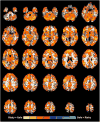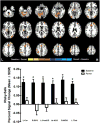Binge drinking impacts dorsal striatal response during decision making in adolescents
- PMID: 26826511
- PMCID: PMC4803619
- DOI: 10.1016/j.neuroimage.2016.01.044
Binge drinking impacts dorsal striatal response during decision making in adolescents
Abstract
Adolescence is a time of both increased risk taking and increased vulnerability to the neurotoxic effects of alcohol. However, it is unclear whether brain functioning abnormalities in adolescent binge drinkers are a result of alcohol use itself or whether they represent premorbid risk characteristics. The current study addresses this question by using a modified version of the Wheel of Fortune (WOF) task, during functional magnetic resonance imaging (fMRI), at both baseline, while all subjects were alcohol-naïve, and revisit, when half of the subjects had emerged into regular binge drinking (n=13) and half remained alcohol and substance-naïve (n=13). Region of interest (ROI) analysis revealed that during decision making, there was a significant binge-drinking related reduction in brain activation in the dorsal striatum, an effect associated with degree of recent use. Furthermore, whole-brain analysis revealed a decrease in fronto-parietal brain activation prior to initiation of alcohol use, in adolescents who went on to binge drink. Additionally, there were numerous regions, both cortical and subcortical, in which there was a significant time-related developmental change, across groups. These results demonstrate how abnormalities in decision-making related circuitry might both lead to and perpetuate alcohol drinking behavior. These findings help aid in our ability to disentangle consequences of binge drinking from potential risk markers for future binge drinking, and may help guide future prevention and intervention strategies.
Keywords: Adolescence; Alcohol; Binge; Decision making; Dorsal striatum.
Copyright © 2016 Elsevier Inc. All rights reserved.
Figures




Similar articles
-
Reduced cerebellar brain activity during reward processing in adolescent binge drinkers.Dev Cogn Neurosci. 2015 Dec;16:110-120. doi: 10.1016/j.dcn.2015.06.004. Epub 2015 Jun 30. Dev Cogn Neurosci. 2015. PMID: 26190276 Free PMC article.
-
Ventral striatal response during decision making involving risk and reward is associated with future binge drinking in adolescents.Neuropsychopharmacology. 2018 Aug;43(9):1884-1890. doi: 10.1038/s41386-018-0087-8. Epub 2018 May 7. Neuropsychopharmacology. 2018. PMID: 29789576 Free PMC article.
-
Binge drinking and family history of alcoholism are associated with an altered developmental trajectory of impulsive choice across adolescence.Addiction. 2017 Jul;112(7):1184-1192. doi: 10.1111/add.13823. Epub 2017 Apr 20. Addiction. 2017. PMID: 28317212 Free PMC article.
-
Mechanisms involved in the neurotoxic, cognitive, and neurobehavioral effects of alcohol consumption during adolescence.Alcohol. 2010 Feb;44(1):15-26. doi: 10.1016/j.alcohol.2009.10.003. Alcohol. 2010. PMID: 20113871 Review.
-
The Burden of Binge and Heavy Drinking on the Brain: Effects on Adolescent and Young Adult Neural Structure and Function.Front Psychol. 2017 Jun 30;8:1111. doi: 10.3389/fpsyg.2017.01111. eCollection 2017. Front Psychol. 2017. PMID: 28713313 Free PMC article. Review.
Cited by
-
Adolescent neural response to reward is related to participant sex and task motivation.Brain Cogn. 2017 Feb;111:51-62. doi: 10.1016/j.bandc.2016.10.003. Epub 2016 Nov 2. Brain Cogn. 2017. PMID: 27816780 Free PMC article.
-
Effects of Binge Drinking on the Developing Brain.Alcohol Res. 2018;39(1):87-96. Alcohol Res. 2018. PMID: 30557151 Free PMC article. Review.
-
Neurobiological Effects of Binge Drinking Help in Its Detection and Differential Diagnosis from Alcohol Dependence.Dis Markers. 2018 Jul 4;2018:5623683. doi: 10.1155/2018/5623683. eCollection 2018. Dis Markers. 2018. PMID: 30069273 Free PMC article. Review.
-
Trajectories of brain development reveal times of risk and factors promoting resilience to alcohol use during adolescence.Int Rev Neurobiol. 2021;160:85-116. doi: 10.1016/bs.irn.2021.08.002. Epub 2021 Oct 7. Int Rev Neurobiol. 2021. PMID: 34696880 Free PMC article. Review.
-
Children's brain activation during risky decision-making: A contributor to substance problems?Drug Alcohol Depend. 2017 Sep 1;178:57-65. doi: 10.1016/j.drugalcdep.2017.02.028. Epub 2017 Jun 4. Drug Alcohol Depend. 2017. PMID: 28641131 Free PMC article.
References
-
- Beck A, Schlagenhauf F, Wustenberg T, Hein J, Kienast T, Kahnt T, Schmack K, Hagele C, Knutson B, Heinz A, Wrase J. Ventral striatal activation during reward anticipation correlates with impulsivity in alcoholics. Biol Psychiatry. 2009;66:734–742. - PubMed
-
- Benjamini Y, Hochberg Y. Controlling the false discovery rate: a practical and powerful approach to multiple testing. Journal of the Royal Statistical Society Series B (Methodological) 1995l:289–300.
Publication types
MeSH terms
Substances
Grants and funding
LinkOut - more resources
Full Text Sources
Other Literature Sources

